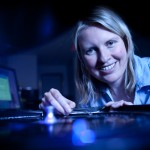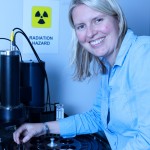Zenobia Jacobs
University of Wollongong
Zenobia Jacobs wants to know where we came from, and how we got here. When did our distant ancestors leave Africa and spread across the world? Why? And when was Australia first settled?

These are difficult and controversial questions. But Zenobia has a deep understanding of time and how to measure it. She has developed a way of accurately dating when individual grains of sand were buried with human artefacts. And that technique is transforming our understanding of human evolution.
As a child growing up in the shadow of the Kruger National Park, Zenobia Jacobs was surrounded by archaeological artefacts ‘lying around’. At university she ‘fell in love’ with archaeology and became an expert in chronology.
She uses a dating technique known as optically stimulated luminescence (OSL). It relies on subtle changes in sand grains due to the decay of tiny amounts of radioactive elements present in all natural deposits. The energy of some of these reactions is stored and only released when light strikes the grain. If the sand is buried then the energy is trapped and can be released in Zenobia’s laboratory- revealing how long the sand, and the human artefacts it was associated with, were buried.
Zenobia has fine tuned OSL, turning it into a robust tool that she used to reveal the appearance and disappearance of communities at caves along the southern coastline of South Africa.
She found a community that had been living relatively sophisticated lives-harvesting shellfish and using ochre pigments for decoration-more than 160,000 years ago, about 120,000 years earlier than previously thought.
(Video production: Jerome Pelletier, Stepping Stone Pictures)
These studies also helped win Zenobia and her colleagues a US$2.5 million National Science Foundation grant in 2006 to develop a detailed archaeological, climate and environmental record for South Africa from 400,000 to 30,000 years ago.
Now her work has brought her to the University of Wollongong to work with Prof Bert Roberts, one of the team who discovered the Flores ‘hobbit’.
“Bert has done more than any other to develop single-grain OSL dating. It’s simply the best lab in the world for my work. I could not ask for more anywhere else.”
And settling in Australia has also allowed her to expand her work. Already she and Bert have used OSL to suggest that the giant marsupials of Tasmania became extinct within a few thousand years of human migration into the area via a land bridge about 43,000 years ago.
And now, with her $20,000 L’Oréal Australia For Women in Science Fellowship, she wants to track the movement of the Aboriginal people into and throughout Australia.
“It’s of incredible relevance to the whole ‘Out of Africa’ theory. When did our ancestors leave Africa? Why? Which routes did they chose and how quickly did they disperse?”
Background
Qualifications
2004 PhD (Science), University of Wales, Aberystwyth, UK
1999 Bachelor of Arts, Honours (Archaeology), University of Stellenbosch, South Africa
Career highlights, awards, fellowships and grants
2009 Senior Research Fellow, School of Earth and Environmental Sciences, University of Wollongong
2008 Australian Research Council grant: The future of palaeolimate and archaeological research in Australia: next generation instrumentation for chronology and environmental reconstruction
2008 Vice Chancellor’s Emerging Researcher Award, University of Wollongong
2007 Australian Research Council grant: A stable-isotope mass spectrometer for novel determinations of past temperatures
2006 Australian Research Council grant: Out of Africa and into Australia: Robust chronologies for turning points in modern human evolution and dispersal
2006 National Science Foundation (USA) HOMINID Grant: Palaeoclimatic and palaeoenvironmental context of the origins of modern humans in South Africa: Constructing a detailed record from 400,000 – 30,000 years ago
2006 -2008 Research Fellow, School of Earth and Environmental Sciences, University of Wollongong
2003 -2005 Scientist, Environmentek, Council for Scientific and Industrial Research, Pretoria, South Africa
2001-2003 British Council Overseas Research Student Scholarship for PhD studies in the UK
Research highlights
- 25 journal articles and reviews including 15 as first author, and two book chapters
- More than 30 presentations at Australian and international conferences and institutions including six invited conference presentations
- Part of the team whose discoveries at Blombos Cave, South Africa, have forced a reassessment of when and where Homo sapiens first developed modern behaviour
- In 2007, she co-authored a publication in Nature, reporting evidence that modern humans living 165,000 years ago along the southern Cape coast of South Africa had a far more complex lifestyle than seen anywhere else in the world at that time
Alternative images:


video: Jerome Pelletier, www.steppingstone.com.au